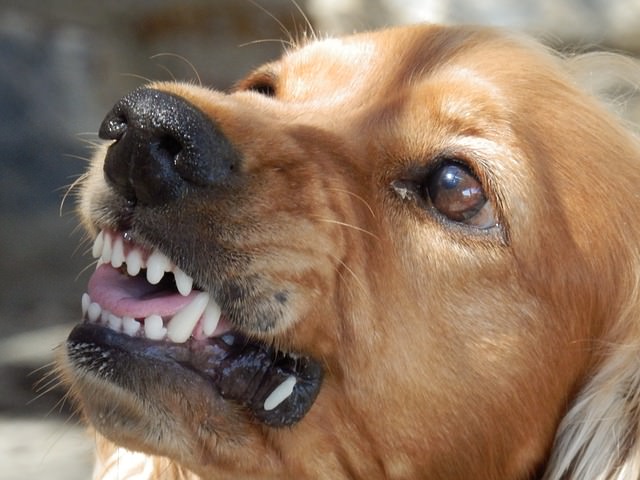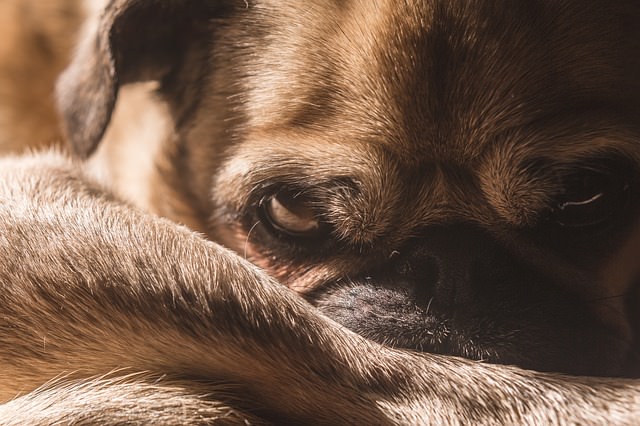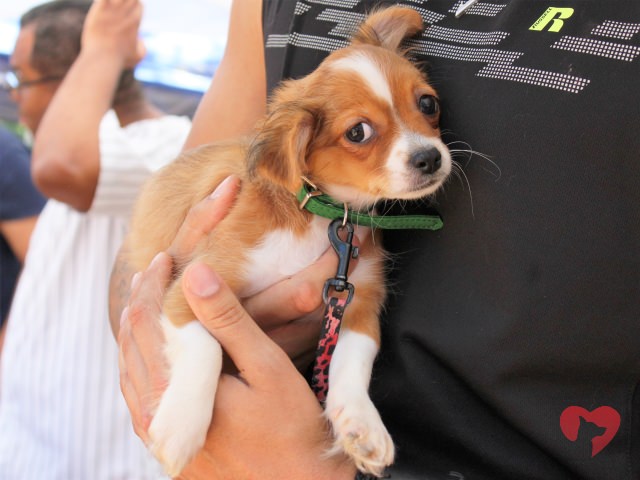Did you know that there are 21 different types of aggression in dogs? Fear aggression is the most common form, even though many people mistake it for dominance aggression.
Each form of aggression must be treated differently – the tools and techniques used to help a dog with dominance aggression will almost always make a dog with fear aggression worse.
So what is fear aggression? How can you tell if your dog has it? Are dogs adopted from shelters more likely to be fear aggressive than puppies raised in one family? Read on for all those answers and more.

What is fear aggression?
You’ve heard about the “fight or flight response,” right? Generally, when a dog is confronted with something scary, it’s first response will be to run away from the threat – flight. If the dog is unable to run away, they may resort to submissive behavior in the hope that the threat goes away, or they may decide they need to fight. So fear aggression is when a dog feels the need to intimidate someone or something that they are afraid of.
What causes and contributes to fear? Dogs who were not socialized properly as puppies are more likely to have many fears – and therefore fear aggression – than those who were introduced to a wide variety of sights, sounds, people, and other dogs when they were puppies. Dogs who were abused are also more likely to have a lot of fears that they approach with aggression.
Since fear is the root of this type of aggression, owners and trainers who use punishment-based techniques can make the situation worse, as they are only adding to the dog’s fear instead of addressing the root causes.
It’s important to note that not all dogs displaying signs of fear aggression will bite. Many only bark or growl when they are afraid. However, heavy-handed approaches at addressing the behavior can make these dogs escalate to biting in the future.

What are the signs?
The differences between fear aggression and dominance aggression can be subtle, and they rely heavily on you being able to read your dog’s body language. Dogsaholic and The Balanced Canine both have excellent infographics to help you decipher your dog’s body language.
Generally speaking, dogs who are fear aggressive will have more of a cowering, retreating posture that those who are dominant aggressive. Fearful dogs will have their ears pinned to their heads, their mouths open and panting while their teeth are bared, and their eyes squinting or so far to the side that you can see the whites of their eyes. Dominance aggressive dogs will have a more upright, rigid posture, their ears are usually up, their mouths are closed when they bare their teeth, and they are looking directly at the threat.
Fearful dogs who bite usually start off with a “snap and retreat” type of bite. They’re trying to get the thing, person, or dog away rather than trying to inflict damage. However, once that behavior achieves the result they want – the source of fear goes away – they can escalate to much more aggressive and damaging bites because they’ve learned that it works. That can make it more difficult to treat the behavior. Whenever possible, it’s best to start addressing fear aggression when it first starts out with growling and snarling, before it progresses to actual biting.
Are dogs from shelters or rescues more likely to be fear aggressive?
While there are no statistics that definitively say that dogs from shelters and rescues are more likely to be fear aggressive than dogs raised in one home, many dogs wind up in shelters as a result of things that can contribute to fear aggression, such as abuse and neglect, or as a result of the symptoms they have developed of fear aggression, such as growling and biting.
Mild to moderate fear aggression can usually be worked out with the right kind of training, so you should never let the worry that you might be adopting a dog with fear aggression stop you from rescuing one.
Since lack of early socialization and being weaned from their mother too early can also cause puppies to be fearful, buying a dog from a breeder, especially an unscrupulous one, is no guarantee that the dog won’t be fear aggressive. Any bad beginning can set a dog up for failure, regardless of where that beginning was.

What are some triggers for fear aggression? Are there things owners might be doing that contribute to or increase the risk for their dog developing fear aggression?
The biggest contributor to fear aggression is a lack of proper socialization. The most important time window for socializing a puppy is from the ages of 3 weeks to 20 weeks old. Puppies this age experience very little fear, so the more they’re exposed to, the less they’ll be afraid of as they get older. This includes new dogs, new people, new objects, new sounds, etc. The more your puppy can see, hear, and do, the less likely they are to develop fear aggression as they get older.
If your puppy is older than 4-5 months old, it’s not too late to start socializing them! You’ll still want to introduce them to new people, dogs, and things. You should avoid walking your dog the same route every day so they can see and experience new places and things. You should teach your dog to be alone to reduce the chances of your dog developing separation anxiety. And you should never punish fear.
Socializing an adult dog is much more difficult. At this point, it becomes more a matter of tackling problems and fears individually. You may need the help of a professional trainer.
For more information on socializing dogs and puppies, check out the Animal Humane Society.
All that being said, dogs have many different triggers that can cause a fear response. Unfamiliar dogs and people are common triggers. Children can be a big trigger for fear aggression, because they haven’t learned how to approach dogs, and small children don’t quite have full control of their limbs yet, posing an intimidating figure to a dog. Kids can also poke eyes or pull ears and tails. Having been hurt by a child, even unintentionally, can have lasting consequences for your dog.
Loud noises can also be very problematic for fearful dogs. Fireworks are especially terrifying. According to animal control officials around the United States, there is a 30-60% increase in lost pets from July 4th through the 6th. One of the busiest days of the year for shelters is July 5. For great tips on keeping your dog safe on the 4th of July, click here.
Can dogs with fear aggression overcome their fears?
While dog aggression can never be fully “cured,” there are many ways to help manage the condition and help your dog overcome their fears. While their fear and aggression may never fully go away, the fears and behaviors can be reduced with proper training.
What to do – and what NOT to do – to help your fear aggressive dog
The best thing you can do is to hire a humane, positive trainer to help you learn proper desensitization techniques. Not everybody can afford a trainer, though, so here are some DO’s and DON’Ts for helping your dog.

DO:
-Figure out what triggers your dog and ways to avoid that trigger as much as possible.
-Make your home environment as predictable as you can. Stick to a routine and try to avoid big surprises.
-Start doing “rituals of behavior.” These actions and behaviors can be practiced by your dog anytime they are in an uncomfortable situation. Read more about “rituals of behavior” here.
-Expose your dog to things they are afraid of one at a time in a controlled manner, starting small in a way that doesn’t frighten your dog. This means showing them the scary thing from a safe distance and rewarding them for not reacting with fear. Over time, slowly bring the scary thing closer for longer periods while rewarding your dog.
-Use your dog’s own body language to keep him calm. Try turning away from the scary thing and pretending to yawn. Keeping yourself calm can help keep your dog calm.
–Back away from a cage or crate door after you open it and use treats to get a fearful dog to come out on their own.
-Practice obedience training. This encourages your dog to listen to you and look to you for cues on how to behave.
-In a house with multiple dogs, make sure there are enough treats and toys to go around to prevent competition.
-Give your dog plenty of exercise. Pent up energy from lack of exercise can contribute to fear reactions.
-Treat underlying health conditions. Many dogs that are suffering from pain or dementia will resort to fear aggression to avoid more pain, or because they are confused. If your older dog suddenly starts displaying symptoms of fear aggression when they hadn’t before, take them to the vet to make sure there aren’t health issues causing the behavior change.
-In severe cases of fear aggression, medication can help reduce your dog’s overall anxiety level. This should be done only as a last-ditch effort and always under the supervision of a veterinarian.
-Ask people to follow your rules when interacting with your dog. A person who thinks they know better than you is likely to reverse your dog’s progress, or worse, get bitten.
-When approaching a fearful dog, you should squat down, turn sideways, and avoid eye contact. Stretch out your arm toward them with your hand open and low to the ground to allow them to sniff it.
-Provide them a dog house or a safe place they can hide when they’re afraid.
DON’T:
-Punish your dog for displaying a fearful reaction. Punishing a fear aggressive dog will only make them more afraid and more aggressive.
-Try to baby talk your dog out of their fear or seem overly nervous. Your dog will see you acting differently and decide that your nervousness and attempts to calm them mean that there is something they should be afraid of. Remaining cool, calm, and collected helps to reassure your dog that everything is okay.
–Look your dog in the eyes. This is a threatening sign and will make your dog put his guard up.
-Reach over or pet the head of a dog who is displaying signs of fear aggression. The hand reaching toward their vulnerable head can frighten them further and lead to a person being bitten.
–Disturb a sleeping dog. Startling a fearful dog will only add to their fear. Try whistling or calling their name from a distance rather than poking or prodding them.
-Physically punish or correct your dog. Again, this will only lead to more fear.
-Allow strangers to approach your dog. If your dog is calm, you may allow your dog to approach the stranger on their own terms, but they should never be forced, and the stranger should be instructed in how to interact with your dog.
-Leave a fear aggressive dog alone with children.
-Make sudden movements or loud noises that may startle your dog.
-Punish your dog. This really can’t be overstated. The only way to help your dog overcome fear aggression is to treat their fears. Punishment will never work and will usually make the problem worse.

How to explain to others about your dog’s fear aggression
Many well-intentioned strangers may think they can walk right up to any dog or have amazing tips that will help. Calmly explain how people should react to your dog and educate them about fear aggression. Explain to them that if they react improperly to your dog, they may be bitten. Give everybody ample warning about how to approach your dog.
Having a fear aggressive dog can be challenging, and working with them to address their fears can be an arduous task. However, there is hope for fear aggressive dogs and you shouldn’t just dump them because you’re afraid to put in the hard work required for them to have a happy, safe life.
Featured Image via Flickr/Jakob Montrasio
